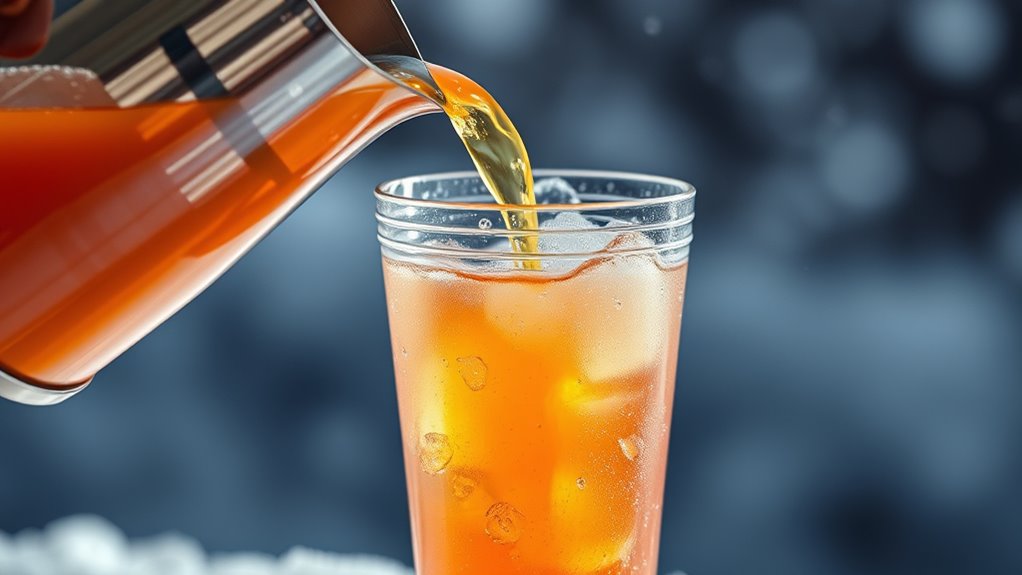Pouring hot juice into a cold glass can cause thermal shock, which may lead to cracks or shattering due to rapid temperature differences. When hot liquid contacts a cold surface, uneven expansion creates internal stresses that your glass might not withstand. To avoid this, use heat-resistant or tempered glassware, and gradually warm or cool your glass before pouring. If you’re interested, you’ll find more ways to prevent damage and stay safe with proper techniques.
Key Takeaways
- Pouring hot juice into a cold glass can create thermal stress leading to cracking or shattering.
- Glasses made of tempered or borosilicate materials resist thermal shock better than standard glass.
- Gradually warming the glass or rinsing with warm water reduces temperature differences and risk.
- Avoid pouring boiling liquids directly into cold glass to prevent internal stresses from rapid heating.
- Proper handling and using heat-resistant glassware enhance safety and prevent breakage.

Have you ever experienced a sudden change in temperature that caused a material to crack or break? It’s a common scenario, especially when dealing with glass. When you pour hot juice into a cold glass, you might not realize how quickly thermal shock can occur. Thermal shock happens when a material experiences rapid temperature changes, causing stress that exceeds its strength. In the case of glass, this stress can lead to cracking or shattering, which emphasizes the importance of understanding glass safety and the material properties that influence how glass responds to temperature shifts.
Sudden temperature changes can cause glass to crack or shatter due to thermal shock.
Glass safety is vital because not all glass is created equal. Some types, like tempered or borosilicate glass, are designed to withstand thermal stress better than regular glass. These specialized glasses have altered material properties that give them higher thermal resistance. For example, borosilicate glass has a low coefficient of thermal expansion, meaning it doesn’t expand or contract much with temperature changes. This makes it less prone to cracking when exposed to sudden temperature differences. Conversely, standard glass has higher thermal expansion properties, making it more vulnerable to thermal shock.
Knowing the material properties of your glassware can help prevent accidents. Glass with high thermal expansion coefficients heats unevenly, creating internal stresses that lead to cracks. When you pour hot liquid into a cold glass, the outer surface heats rapidly while the interior remains cool, creating a temperature gradient. This uneven heating causes the surface to expand faster than the interior, putting stress on the glass. If the stress surpasses the glass’s strength, it can break unexpectedly. That’s why understanding these material properties helps you choose the right glassware for hot and cold liquids and avoid mishaps.
To reduce the risk of thermal shock, always consider the glass’s suitability for hot liquids. Use glassware labeled as heat-resistant or designed for thermal shock. Gradually warming or cooling the glass before pouring hot liquids also helps mitigate sudden temperature differences. For example, rinsing the glass with warm water before pouring hot juice allows the glass to adjust more slowly to the temperature change. Avoid pouring boiling liquids directly into cold glass, as the rapid temperature shift can surpass the material’s limits and cause breakage.
In essence, understanding glass safety and the material properties of your glassware can save you from potential accidents. Recognizing how different types of glass respond to temperature changes helps you handle them more carefully. By choosing the right glass and applying proper pouring techniques, you can enjoy hot beverages without risking cracks or shattering. Thermal shock isn’t just a physics concept; it’s a practical concern that influences everyday safety in your kitchen. Additionally, material properties like thermal expansion coefficients play a crucial role in determining the durability of glass under temperature stress.
Frequently Asked Questions
Can I Reuse Glass After Experiencing Thermal Shock?
You shouldn’t reuse glass that has experienced thermal shock, as it may have developed microcracks from thermal expansion. These cracks weaken the glass and can cause it to break unexpectedly. Instead, consider recycling the glass, but only if it’s properly processed. Reusing compromised glass poses safety risks, so it’s best to dispose of it responsibly. Always inspect for damage before reusing, and when in doubt, opt for recycling to prevent accidents.
What Types of Glassware Are Most Resistant to Thermal Shock?
Your best bet for resisting thermal shock is borosilicate glass, which boasts incredible durability that can withstand sudden temperature changes like a superhero facing a villain. Tempered glass also offers impressive strength, making it less likely to break under thermal stress. These types of glassware are designed to handle hot and cold liquids without cracking, ensuring your drinkware remains intact and safe, no matter how extreme the temperature difference.
How Can I Tell if My Glass Has Been Damaged by Thermal Shock?
You can tell if your glass has been damaged by thermal shock through a visual inspection—look for tiny cracks, cloudiness, or irregularities on the surface. Glass cracking might be subtle at first, but these signs indicate stress from temperature changes. Handle the glass carefully, especially if it feels rough or shows any fractures, as it could break unexpectedly. Always inspect your glassware before use to prevent accidents.
Is There a Safe Way to Heat Glass Gradually to Prevent Shock?
Think of gentle temperature regulation as a comforting embrace for your glass. To prevent thermal shock, slowly warm your glass using warm water or a low-temperature oven, respecting the glass material’s limits. Avoid sudden temperature changes, and don’t place it directly over a heat source. This careful approach helps your glass adapt smoothly, ensuring your favorite drink stays safe and unscathed while prolonging its beautiful life.
Do All Liquids Pose the Same Risk of Causing Thermal Shock?
Not all liquids pose the same risk of causing thermal shock. Your risk depends on liquid viscosity and thermal expansion, which influence how heat transfers. Thicker liquids with higher viscosity transfer heat more slowly, reducing shock. Conversely, liquids with rapid thermal expansion can cause glass to crack if poured too quickly. To minimize risk, always pour hot liquids gradually and choose heat-resistant glassware designed to handle thermal stress.
Conclusion
Just like Icarus who soared too close to the sun, pouring hot juice into a cold glass risks a fiery fall. Your hands, like a cautious hero, must heed the silent warning of thermal shock. Remember, patience is your shield against sudden cracks and unexpected spills. By respecting the delicate dance of temperature, you keep your glass intact—staying grounded while the world around heats up. Embrace the calm, and let safety be your steady guide.
Cindy thoroughly researches juicing trends, techniques, and recipes to provide readers with practical advice and inspiration. Her writing style is accessible, engaging, and designed to make complex concepts easy to understand. Cindy’s dedication to promoting the advantages of juicing shines through her work, empowering readers to make positive changes in their lives through the simple act of juicing.











